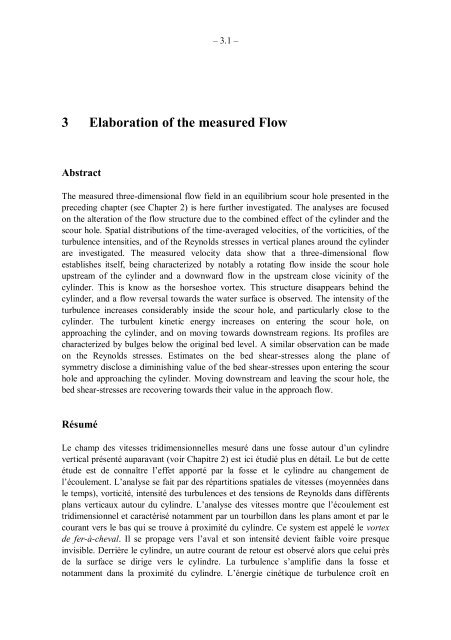You also want an ePaper? Increase the reach of your titles
YUMPU automatically turns print PDFs into web optimized ePapers that Google loves.
– 3.1 –<br />
3 Elaboration of the measured Flow<br />
Abstract<br />
The measured three-dimensional flow field in an equilibrium scour hole presented in the<br />
preceding chapter (see Chapter 2) is here further investigated. The analyses are focused<br />
on the alteration of the flow structure due to the combined effect of the cylinder and the<br />
scour hole. Spatial distributions of the time-averaged velocities, of the vorticities, of the<br />
turbulence intensities, and of the Reynolds stresses in vertical planes around the cylinder<br />
are investigated. The measured velocity data show that a three-dimensional flow<br />
establishes itself, being characterized by notably a rotating flow inside the scour hole<br />
upstream of the cylinder and a downward flow in the upstream close vicinity of the<br />
cylinder. This is know as the horseshoe vortex. This structure disappears behind the<br />
cylinder, and a flow reversal towards the water surface is observed. The intensity of the<br />
turbulence increases considerably inside the scour hole, and particularly close to the<br />
cylinder. The turbulent kinetic energy increases on entering the scour hole, on<br />
approaching the cylinder, and on moving towards downstream regions. Its profiles are<br />
characterized by bulges below the original bed level. A similar observation can be made<br />
on the Reynolds stresses. Estimates on the bed shear-stresses along the plane of<br />
symmetry disclose a diminishing value of the bed shear-stresses upon entering the scour<br />
hole and approaching the cylinder. Moving downstream and leaving the scour hole, the<br />
bed shear-stresses are recovering towards their value in the approach flow.<br />
Résumé<br />
Le champ des vitesses tridimensionnelles mesuré dans une fosse autour d’un cylindre<br />
vertical présenté auparavant (voir Chapitre 2) est ici étudié plus en détail. Le but de cette<br />
étude est de connaître l’effet apporté par la fosse et le cylindre au changement de<br />
l’écoulement. L’analyse se fait par des répartitions spatiales de vitesses (moyennées dans<br />
le temps), vorticité, intensité des turbulences et des tensions de Reynolds dans différents<br />
plans verticaux autour du cylindre. L’analyse des vitesses montre que l’écoulement est<br />
tridimensionnel et caractérisé notamment par un tourbillon dans les plans amont et par le<br />
courant vers le bas qui se trouve à proximité du cylindre. Ce system est appelé le vortex<br />
de fer-à-cheval. Il se propage vers l’aval et son intensité devient faible voire presque<br />
invisible. Derrière le cylindre, un autre courant de retour est observé alors que celui près<br />
de la surface se dirige vers le cylindre. La turbulence s’amplifie dans la fosse et<br />
notamment dans la proximité du cylindre. L’énergie cinétique de turbulence croît en

















